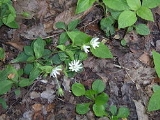
Stellaria pubera
Encyclopedia
Stellaria
pubera (star chickweed) is a wildflower found in the eastern United States and the Great Smokey Mountains.
Star Chickweed Stellaria pubera
Identification:
Looking closely at Star Chickweed, you can see what appears to be 10 petals are actually 5 that are deeply cleft. Notched petals is a characteristic of this taxonomic group – the Pink family. The blossom does however, look star-like, with its white, pointed petals surrounding a yellow center. Stamens arising from the center are tipped with dark anthers. Take a close look at the stem. You will see rows of hairs running up the stem, switching sides at each node. This characteristic gives this plant its specific epithet: “pubera” – meaning hairy.
An early spring bloomer, star chickweed may be seen as early as April. It grows 6-12 inches high. The leaves are oval shaped, growing opposite one another along the weak and sometimes reclining stem.
There are more than a dozen other species of chickweed, many of which were introduced from Europe. One of these exotics, common chickweed, Stellaria media, is often pulled as a weed, and can be told from native star chickweed as common chickweed is quite hairy on stem and leaves. Star chickweed, sometimes called Great Chickweed, is so named because compared to all it’s relatives, this plant has large showy flowers.
Natural History:
The star-shaped flowers of Star Chickweed inspired the common and Latin name for this flower. Stellaria comes from the Latin word stellar which means star-like. Pubera, meaning hairy, comes from the lines of hairs that line the stem. It has a long growing season, and produces many tiny seeds. These seeds are commonly eaten by birds, hence its name “chickweed” or another common name given this plant is "bird seed" for this reason.
Europeans do not so readily view the hearty chickweed, that commonly invades gardens, as a pest. Before flowering in the early spring, it is commonly harvested, cooked, and eaten as a tender, nutritious green. Chickweed contains high amounts of vitamins A and C.
Chickweed was collected during ancient times for medicinal purposes. It was used as a treatment for high fevers and could also be chopped up into a poultice to treat infected sores. Herbalists have prescribed it to treat arthritis, cramps, skin diseases, and rheumatic pains. These treatments are not supported by modern medical practices however.
When you notice star chickweed, keep in mind an old mountain wives tale which claims the plant can predict the weather. If you see the blossoms wide open, you can bet on at least 4 more hours without rain. If you see the blossoms closed down, grab your raincoat.
.
Conservation:
Star Chickweed is endangered in the state of New Jersey. Common chickweed, as its name implies flourishes throughout the US making itself a bothersome weed as it creeps into gardens. There is no conservation concern for either plant.
Stellaria
Stellaria is a genus of about 90-120 species flowering plants in the family Caryophyllaceae, with a cosmopolitan distribution. Common names include stitchwort and chickweed.-Food use:...
pubera (star chickweed) is a wildflower found in the eastern United States and the Great Smokey Mountains.
Star Chickweed Stellaria pubera
Identification:
Looking closely at Star Chickweed, you can see what appears to be 10 petals are actually 5 that are deeply cleft. Notched petals is a characteristic of this taxonomic group – the Pink family. The blossom does however, look star-like, with its white, pointed petals surrounding a yellow center. Stamens arising from the center are tipped with dark anthers. Take a close look at the stem. You will see rows of hairs running up the stem, switching sides at each node. This characteristic gives this plant its specific epithet: “pubera” – meaning hairy.
An early spring bloomer, star chickweed may be seen as early as April. It grows 6-12 inches high. The leaves are oval shaped, growing opposite one another along the weak and sometimes reclining stem.
There are more than a dozen other species of chickweed, many of which were introduced from Europe. One of these exotics, common chickweed, Stellaria media, is often pulled as a weed, and can be told from native star chickweed as common chickweed is quite hairy on stem and leaves. Star chickweed, sometimes called Great Chickweed, is so named because compared to all it’s relatives, this plant has large showy flowers.
Natural History:
The star-shaped flowers of Star Chickweed inspired the common and Latin name for this flower. Stellaria comes from the Latin word stellar which means star-like. Pubera, meaning hairy, comes from the lines of hairs that line the stem. It has a long growing season, and produces many tiny seeds. These seeds are commonly eaten by birds, hence its name “chickweed” or another common name given this plant is "bird seed" for this reason.
Europeans do not so readily view the hearty chickweed, that commonly invades gardens, as a pest. Before flowering in the early spring, it is commonly harvested, cooked, and eaten as a tender, nutritious green. Chickweed contains high amounts of vitamins A and C.
Chickweed was collected during ancient times for medicinal purposes. It was used as a treatment for high fevers and could also be chopped up into a poultice to treat infected sores. Herbalists have prescribed it to treat arthritis, cramps, skin diseases, and rheumatic pains. These treatments are not supported by modern medical practices however.
When you notice star chickweed, keep in mind an old mountain wives tale which claims the plant can predict the weather. If you see the blossoms wide open, you can bet on at least 4 more hours without rain. If you see the blossoms closed down, grab your raincoat.
.
Conservation:
Star Chickweed is endangered in the state of New Jersey. Common chickweed, as its name implies flourishes throughout the US making itself a bothersome weed as it creeps into gardens. There is no conservation concern for either plant.

